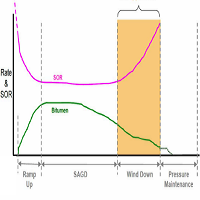NCG - End of life support for SAGD
 Steam-oil-ratio (SOR) skyrockets during the wind down-phase of a SAGD scheme. This is partly due to the reduced bitumen production. Because of the increased SOR, cost per barrel of bitumen produced soars during this wind-down phase.
Steam-oil-ratio (SOR) skyrockets during the wind down-phase of a SAGD scheme. This is partly due to the reduced bitumen production. Because of the increased SOR, cost per barrel of bitumen produced soars during this wind-down phase.
What if we could use non-condensable gas injection during the wind down phase to increase recovery and reduce the cost of generating steam. That's the proposal of this operator. He wants to field test gas injection during wind down to see if costs can be reduced without sacrificing recovery. We found this information using AppIntel..
Get his submission documents from our self-serve web portal.
Buy these submission docs now Subscribers get them for free?subject=Help me get up to speed on NCG&body=Help me get up to speed on NCG injection in SAGD. I'm interested in your survey of the variety of uses.%0D%0A%0D%0AMy Name:__________ %0D%0AMy Phone Number:__________ %0D%0A%0D%0A(Or call Proven Sales at 403-803-2500.)">Contact Proven for a survey of NCG in a variety of uses.
Non-condensable gas injection is being tried by more and more operators for a variety of reasons. Operators are using it during blowdown. They are using NCG in conjunction with infill wells. In fact many different uses for NCG have been proposed since 2009.
Each AER application contains your neighbor's perspective on the exploitation of oil and gas formations. Applications contain more technical data even than SPE papers.
Would you like to see what other operators in your areas are thinking about seismic, commercial schemes, experimental schemes and recovery? AppIntel can help.
Tags: Gas Injection, Thermal, Cut costs, Heavy Oil
11 Jul 2016

Non-meridian thermal wells
Still drilling horizontal wells N-S? Why?

Steam surfactant co-injection
Want to win? What is your competitive advantage?

Surprise! Sour gas production from a sweet thermal scheme
Dealing with surprises in the oil and gas industry. What to do next.

10 ways to increase production before Christmas - Infographic
For your wall to remind you

10 ways to increase production before Christmas
Each cost less than half a million




 Calgary, Alberta, Canada
Calgary, Alberta, Canada
 Share
Share